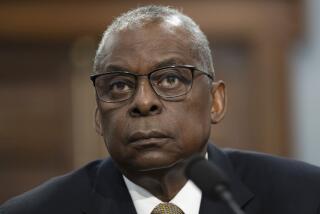Pacific Rim Nations Seeking Unity : Trade: Economic cohesiveness is the goal as 12 nations meet in Australia. But no dramatic gains are expected.
- Share via
CANBERRA, Australia — What Australian Prime Minister Bob Hawke called “the Pacific century” began cautiously Sunday when the leaders of 12 Pacific Rim nations opened an economic cooperation conference that is audacious in concept but modest in expectations.
Secretary of State James A. Baker III led a U.S. delegation that also includes Commerce Secretary Robert A. Mosbacher and trade negotiator Carla Anderson Hills. The conference is the first comprehensive attempt to meld the Pacific region’s disparate and often feuding nations into a cohesive organization.
The nations joining the United States here in the Australian capital include Japan, South Korea, Canada, Australia, New Zealand and the six members of the Assn. of Southeast Asian Nations--Brunei, Indonesia, Malaysia, the Philippines, Singapore and Thailand.
“Closer, more effective regional cooperation is an idea whose time has come,” Hawke said. “We are entering or have already entered the Pacific century.”
Hawke conceded that the notion has been coming for a long time. Proposals for Pacific Rim economic blocs have been made at least since the mid-1960s but have always foundered because, in the final analysis, the nations of the region have little in common except for their geography.
The plan may fare better this time because the 12 nations are also motivated by a newly realized need to prevent the region’s economic frictions from sapping its remarkable economic growth.
The United States is applying pressure to Japan and South Korea to open their markets to more American goods. In Korea, at least, the effort has produced an upsurge of anti-Americanism. The other 10 countries are concerned about the domination of the superpowers in Tokyo and Washington. Malaysia is free-trade oriented, while Singapore is protectionist. The list of potential disputes is staggering.
But supporters of the conference hope problems that have defied solution in bilateral terms can be solved in the larger context.
An Australian official said the process will give the other 10 countries greater leverage in their dealings with the United States and Japan. He said it could provide “a way of making our interests count.”
A senior State Department official said the conference will give the United States and Japan a way to “communicate a sense of the positive possibilities for the other nations in the region without posing a threatening role.”
However, no one expects the new forum to produce dramatic results. The conference will reach decisions by consensus, meaning that any one of the participants can veto any proposed action. For this reason, organizers have decided not to try to craft a final communique, a process that often results in lengthy squabbles over wording.
U.S. and Australian officials said that the only concrete decision they expect is an agreement to hold at least two more similar meetings. Indonesia has offered to host a meeting in 1990, and South Korea has offered to hold one in 1991.
All 12 nations seem to agree that the meeting, officially called the Asia Pacific Economic Cooperation conference, will not evolve into a trading bloc like the European Community.
“We do not meet here at this time with any hidden agenda to create some form of Pacific trading bloc,” Hawke said. “Our commitment is to open, multilateral trade. Our united resolve is that the world economy should not fragment into defensive trading blocs.”
Despite their differences, all 12 nations at the conference profess capitalistic economic systems. U.S. officials like to suggest that the meeting is also one of political democracies. This is certainly true in many cases, but Brunei is an absolute monarchy, and some of the other nations practice only limited democracy.
A U.S. official said the group’s “unifying principle is market economics.”
Left out of the meeting, at least for the time being, are two of Asia’s fastest growing and dynamic economies, Hong Kong and Taiwan. The two, along with Singapore and South Korea, make up Asia’s so-called Four Tigers--the newly industrialized nations that are pushing their way into the first rank of the world’s economic powers.
Organizers of the conference concluded that Taiwan and Hong Kong could not be included as long as the People’s Republic of China was left out. After Beijing’s suppression of pro-democracy demonstrations last June, the inclusion of China this time was out of the question.
Nevertheless, the United States, Japan and Australia all say that eventual inclusion of China, Taiwan and Hong Kong should be discussed. The issue is made more complex because both Beijing and Taipei claim to be the capital of China, while Hong Kong, now a British colony, is scheduled to become part of China in 1997.
Conference sources say that the six ASEAN nations are the most strongly opposed to including the rival Chinese entities.
Times staff writer Art Pine, in Washington, contributed to this story.
More to Read
Sign up for Essential California
The most important California stories and recommendations in your inbox every morning.
You may occasionally receive promotional content from the Los Angeles Times.













